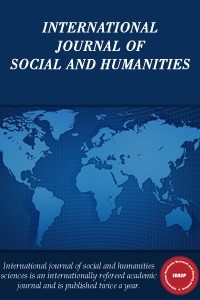BİZANS MİRASI MİMARLIK VE SANAT
Bizans Mimarisi, Bizans Mozaikleri, Neo Bizans Akımı
THE LEGACY OF BYZANTINE ARCHITECTURE AND ART
Byzantine Architecture, Byzantine Mosaics, Byzantine Art,
___
- Baker, P. (2002), Early Christian and Byzantine, in: The Grammar of Architecture, ed., Emily, C., E, Bulfinch Press, Boston, 148-165
- Banham, J. (1997), Encyclopedia of Interior Design, Fitzroy Dearborn Publishers, Chicago
- Bogdanovic, J. (2017), The Framing of Sacred Space: The Canopy and the Byzantine Church, Oxford University Press
- Bolak, O. (1967), Camilerin Aydinlatilmasi Uzerine Bir Arastirma, (in Turkish) (A Research on Mosque Lighting), Istanbul Technical University, Faculty of Architecture, Istanbul,
- Bullen, J.B. (2006), Byzantium Rediscovered, Phaidon
- Crouch, D.P. (1985), History of Architecture, McGraw-Hill, New York
- Duzguner, F. (2004), Iustinianus Doneminde Istanbul’da Yapilar, Arkeoloji ve Sanat, Istanbul
- Duzguner, F. (2006), Istanbul: an Anatolian miracle designed in Byzantion period (in Turkish), Mimarist 21, 91-102
- Fitoz, I., Berkin, G. (2007), Space, light and beliefs the use of daylighting in churches and mosques, Arkitekt,/04-05 (p.12-24)
- Grant, M. (1998), From Rome to Byzantium the Fifth Century AD, Routledge
- Hoffmann, V. (2005), Der Geometrische Entwurf Der Hagia Sophia in Istanbul, Ausstellung, Germany,
- Mainstone R.J. (1998), Hagia Sophia, Thames and Hudson, London,
- Mango, C. (2006), Bizans Mimarisi, (in Turkish) (Byzantine Architecture), trans. M. KADIROGLU, Rekmay, Ankara,
- Ousterhout, R. (2008), Master Builders of Byzantium. University of Pennsylvania, Philadelphia,
- Schibille, N. (2014), Hagia Sophia and the Byzantine Aesthetic Experience, Ashgate, England
- Speltz, A. (1996), Styles of Ornament, Bracken, London
- Stricland, C. (1992), The Annotated Mona Lisa, Andrews Mc Meel
- ISSN: 2602-3288
- Başlangıç: 2017
- Yayıncı: Tuncay AYDEMİR
İŞLEV DEĞİŞTİREN BİR İBADET YAPISININ KENT KİMLİĞİ ÜZERİNDEN OKUNMASI; GİRESUN KAPUSEN KİLİSESİ
İSLAM HUKUKU İLE BEŞERİ HUKUKUN BİRBİRİNDEN YARARLANMA İMKÂNI ÜZERİNE
KENTSEL KALKINMADA KADINLAR VE TOPLUMSAL CİNSİYET
Njomëza TASHA, Luan VARDARİ, Dena ARAPİ
“U” NARTEKSLİ GEÇ DÖNEM KİLİSELERİ II – AYVALIK
SÜRDÜRÜLEBİLİR YEREL PLANLAMADA COĞRAFİ BİLGİ SİSTEMİ
TÜRK İŞ HUKUKUNDA İŞYERİNDE ŞİDDET VE UYGULANACAK HUKUKİ YAPTIRIMLAR
